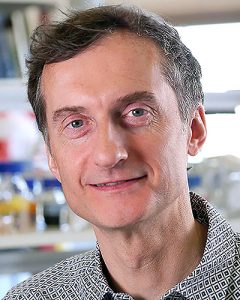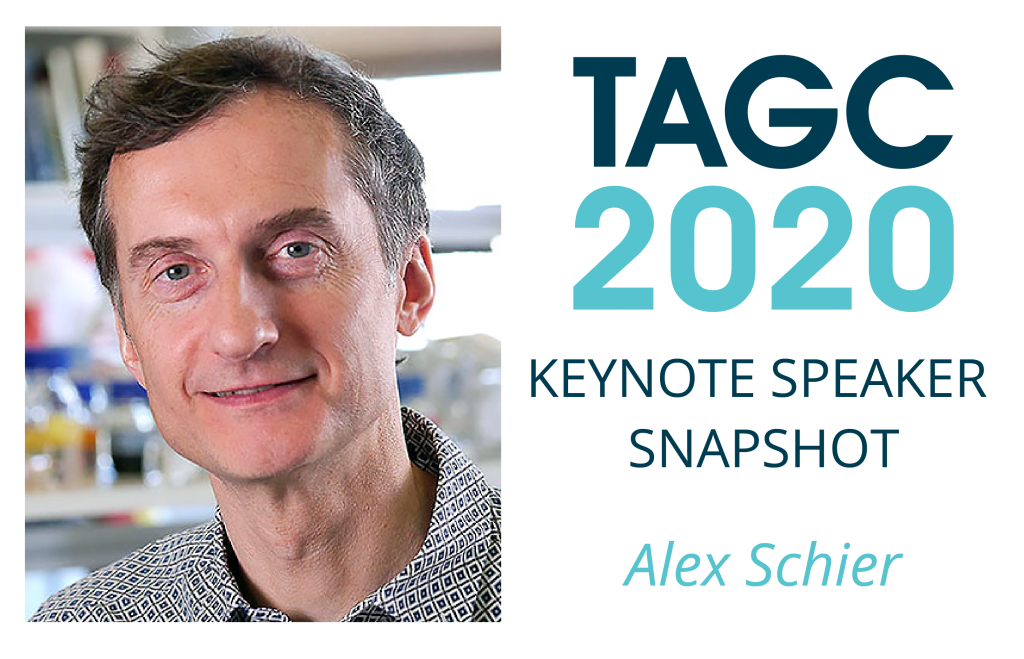Get to know the TAGC 2020 Keynote Speakers through our interview series.

Alex Schier
Alex Schier obtained his PhD in Walter Gehring’s lab at the Biozentrum Basel. He spent his postdoc in Wolfgang Driever’s lab at Harvard, where he screened for and characterized mutants affecting zebrafish development. He started his lab in 1996 at the Skirball Institute of NYU School of Medicine and joined Harvard University in 2005. In 2019, he returned to the Biozentrum Basel. His lab has contributed to the understanding of the molecular basis of vertebrate embryogenesis and behavior and to the development of zebrafish as a model system. Schier has received NIH MERIT and PIONEER awards and was elected to EMBO.
What research are you most excited about right now, and why?
The whole field of building trees for development is pretty exciting. We are now building trajectory trees with single-cell sequencing; we can reconstruct the molecular trajectory a cell goes through as it differentiates. We can also build lineage trees that reconstruct the ancestral relationship between cells. There are still many challenges to building these trees. The technical challenge is to make them accurate, deep, and complete. Biologically, the challenge is figuring out what we’re actually going to learn from them. Still, there is a feeling of a new era that should hopefully provide exciting insights in the future.
It’s also exciting that single-cell approaches let us capture and define cell types at a level we couldn’t achieve before. We can identify new cell types and compare cell types between organisms. We can try to reconstruct the evolutionary history of cell type diversification. We can reconstruct the molecular trajectory of a cell during differentiation, letting us understand at the whole genome level how cells acquire specific structures and functions. The whole field is very exciting. At the moment, it’s largely technology and phenomenology, but I’m optimistic that some exciting biology will come out of this.
What do you like about working with zebrafish?
In a nutshell: transparent mutants. That’s the real power of the fish: they’re visually accessible. You can really see everything at the cellular and subcellular level, allowing you to do amazingly deep phenotyping on everything from brain activity to neuronal connections to cell migration to nuclear morphology and more. And with transgenic technologies and CRISPR, it’s easy to manipulate the genome. The road from genotype to phenotype is very short, and now genotype and phenotype changes can be made and detected at a very fine scale.
Is there anything about yourself or the field that made you feel like you didn’t belong in science? What would you say to early career scientists struggling with the same feeling?
I have always felt at home in science: thinking about science and how to approach the world as a scientist felt natural. However, there were definitely instances when I was not sure if I felt at home in the scientific community.
For example, I was an intern at a big pharma company in college, and I remember being disappointed that people did science but didn’t seem to have passion behind what they were doing. It seemed more like a job than a calling, which didn’t seem much fun. That’s not generally true—there are lots of passionate scientists in biotech/pharma—but that summer, I wasn’t sure that this community was for me. Maybe that’s why I stayed in academia.
As a grad student, I once spoke to a very famous developmental biologist at a conference. As soon as he saw someone more important than me, he ended our conversation and walked away. It was rude, of course, but more than that, it felt like only the opinions of famous people counted.
I would tell early career scientists: find your niche and find your support network. There will always be people who think like you and love science and went through similar struggles to become a scientist, so I think there will always be people to offer support.
Science is still one of the most meritocratic professions. It’s not perfect—there are biases—but creativity and rigor go a very long way in science, no matter your background. If you’re creative and rigorous, do beautiful experiments, work hard, and create new knowledge, people will respect you. That’s something I like about science compared to other professions.
TAGC aims to foster collaboration between communities and disciplines. Can you give an example of a collaboration that really helped your work?
I have been super lucky to have had many generous and fun collaborators throughout my career. I did a big genetic screen as a postdoc, and it was only possible through collaboration. No single person could’ve done it. It took a large group, sharing ideas, doing it together. It was magical.
As a starting PI, I had a wonderful collaboration with Will Talbot. We really fed off each other studying early zebrafish embryogenesis. When I moved to Harvard, I started working with Florian Engert and moved more into neurobiology. We came from very different fields and had very different personalities, and many things have happened between the two labs that couldn’t have happened individually. We’ve been trying to get at the connection of behavior to neural activity, of behavior to genetics.
More recently, on our genomics work, we’ve collaborated with Aviv Regev and Jay Shendure. This has really been the perfect combination of people with different backgrounds working together, creating more than the sum of their parts. Collaborations make research both better and more fun.
Select Publications from the Schier Lab
Phenotypic landscape of schizophrenia-associated genes defines candidates and their shared functions
Thyme SB, Pieper LM, Li EH, Pandey S, Wang Y, Morris NS, Sha C, Choi JW, Herrera KJ, Soucy ER, Zimmerman S, Randlett O, Greenwood J, McCarroll SA, Schier AF
Cell. 2019 Apr 4;177(2):478-491.e20. doi: 10.1016/j.cell.2019.01.048
Single-cell reconstruction of developmental trajectories during zebrafish embryogenesis
Farrell JA, Wang Y, Riesenfeld S, Shekhar K, Regev A, Schier AF
Science. 2018 Jun 1;360(6392). doi: 10.1126/science.aar3131
Simultaneous single-cell profiling of lineages and cell types in the vertebrate brain by scGESTALT
Raj B, Wagner DE, McKenna A, Pandey S, Klein AM, Shendure J, Gagnon JA, Schier AF
Nature Biotechnology. 2018 Jun;36(5):442-450. doi: 10.1038/nbt.4103
Vg1-Nodal heterodimers are the endogenous inducers of mesendoderm
Montague TG. Schier AF
eLife. 2017 Nov 15;6. doi: 10.7554/eLife.28183
Nodal patterning without Lefty inhibitory feedback is functional but fragile
Rogers KW, Lord ND, Gagnon JA, Pauli A, Zimmerman S, Aksel DC, Reyon D, Tsai SQ, Joung JK, Schier AF
eLife. 2017 Dec 7;6. doi: 10.7554/eLife.28785































